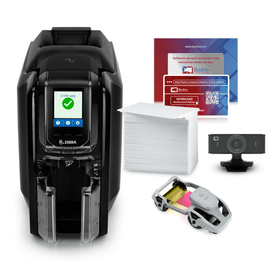There are many organizations these days, which use ID cards primarily as a means of identifying employees and visitors. In such places, security is often not as robust as it should or could be. This is not to say that every single company in every industry should uphold security standards like those of the CIA or NSA, but something has definitely got to give. Any corporation can benefit from making sure that access to its workspaces and property is regulated based on authorization. Of course, the need for security of this kind must be weighed against what the company is able to pay for it. Luckily, there are plenty of attractive options, which deliver top-notch security when it comes to ID cards.
Data versus Security
Imagine being given the job of finding suitable security for the ID cards used in your organization. The first question is, Where to start? Lower security levels can satisfy the requirement of a spectrum of organizations, and so for your standard corporate entity, you would choose that. You should, however, take special care when choosing the software that will be used to code all the IDs; that matters no matter what technology you use. With something inferior, you could end up holding a bunch of useless plastic slices that get no one past security, so make sure to choose something that can print barcodes and QR codes, as well as smart chips.
The data aspect needs to be weighed against security so that you can narrow down the options and hone in on the right one for you. When you have data storage on the ID cards as a matter of higher priority than security itself, you need no more than bar codes, magnetic stripes, or QR codes. Each of these still delivers in terms of security, but that is the number one concern. Bar codes, for example, can hold close to 100 characters, and that is plenty when you are seeking a means of primary identification. There would also need to be a scanner that is able to read this information.
QR codes are able to store 2000 characters max, and there is the added benefit that these can be read by most modern smartphones sold today. Magnetic stripes while able to carry a maximum of 926 data bits, are limited by the requirement of a magnetic stripe reader. However, the higher data storage capacity is definitely a plus, especially when used in access control cards. Bar codes, magnetic stripes, and QR codes are all excellent choices when you have data as a higher priority than security.
Deciding on the Level of Security
Suppose security was not a less important concern, and that you are in a business that calls for substantial and effective protection from corporate espionage and the like. Alternatively, you may simply wish to build up a feeling of physical security inside the building or compound. One of the best ways is to add a holographic laminate to the ID cards, so that they are rendered almost impossible to forge. This could be a custom image or the logo of the company; as long as it is something unique, no one would be able to make an unauthorized copy of the card.
You could take this further and incorporate a “smart chip” feature, which balances data and security beautifully. A chip like this can hold from 8,000 to 128,000 data bits, which is a good deal more than a mag stripe’s capacity. Smart chips are compelling when you look at them from a security perspective, because no one can access these without the required permissions. There are even further ways to sharpen up that feature, but those are not easily bought. For an average organization with an eye on enhanced security, a regular smart chip is often more than enough to make them more secure than the competition.
Biometric cards are another great option for superior security. These allow you to mix tech and biology in a way that makes your organizational security foolproof. Only the owner of the card has the exact same identifying mark, which means even borrowing access is theoretically impossible. It would be like something out of a Bond movie, because getting used to it does not mean it is not a big deal.
All of the above options can be availed easily enough on today’s market, but you need to first decide which one suits the security requirements of your company. Consider the different aspects of your situation before deciding on any one option. There is also an array of ID card printers with wide-ranging features, such as IDP dipsmart70 for example, so you need to decide if you are going to buy one or just outsource the printing to someone else. If you choose the former, then there is also the matter of finding and buying the right card printer for your needs.
















